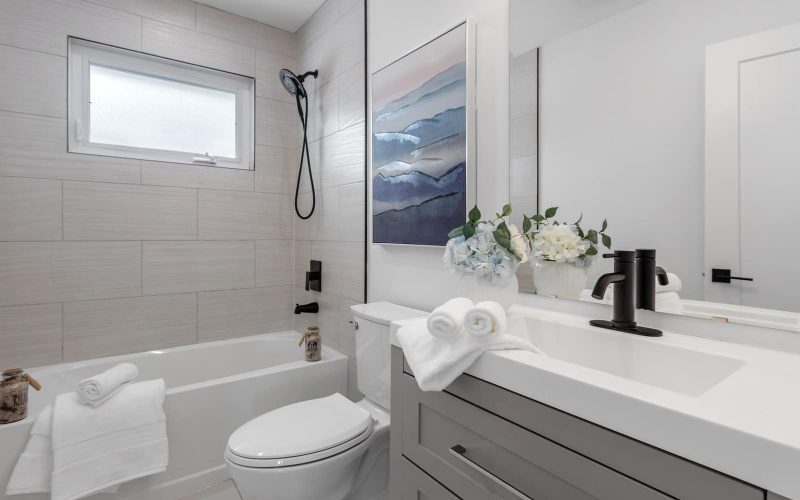Learn about the different types of showers. When it comes to purchasing a shower for your bathroom, there are numerous alternatives and considerations.
Today, we’ll review the intricacies and possibilities you might not have considered! Shower type, style, and design are the most important.
Then there are the smaller but equally important considerations, such as door type, shower head type, and any additional amenities you want to include to help create the best bathing experience. We’re in there virtually every day, after all!
Of course, you can always prefer a pre-built, prefabricated shower instead of a personalized design. Selecting the correct shower to fit your area might be even more difficult.
Now, let’s start by looking at the various types of showers we have. So please read on.
1. Manual Mixer Shower
The classic shower valve is a manual mixer shower. You can still find it in the majority of modern bathrooms.
However, the mixer combines hot and cold water every time you shower. Also, adjust the valve controls to a specified temperature each time you shower.
Manual mixer showers are simple to use and install. This is, without a doubt, the most cost-effective shower valve on the market.
2. Thermostatic Mixer Shower
A thermostatic shower is recommended for families with small children. This ensures that the shower water is kept at the proper temperature.
A thermostatic valve controls the water temperature in each shower. Set the temperature to your preference, and each shower will be at the same temperature.
Furthermore, it’s also less taxing on your shower pump. This dependable shower system minimizes scalding, making it safer for young children and elderly families. However, it necessitates knowing the ideal water temperature for each household member!
Because you are not personally adjusting the temperature but delegating it to an internal control system, thermostatic mixers with a digital control panel are often called “digital showers.”
3. Electric Shower
Unlike thermostatic and manual mixers, electric showers do not require a hot water source. As long as there’s a cold water supply, you’re good to go. A built-in heating unit heats cold water in electric showers.
Electric showers are an excellent alternative for remodeling a home basement because they do not require a connection to a hot water source.
However, these are not the most energy-efficient because it takes too much energy to heat the cold water supply. This is one of the different types of showers.
4. Power Shower
Because it is equipped with a pump, a Power Shower, also known as a Pumped Shower, is excellent for a low-pressure water supply.
These are the most popular showers in hotels and spas. On the other hand, a power shower is a fantastic addition to your home because the built-in pump automatically pumps water at a high rate.
This shower is ideal for your bathroom if you want to enjoy the ultimate in luxurious showering daily. However, its main disadvantage is that it uses a lot of water.
It can also be highly costly to install and repair. A power shower suits all gravity-fed systems when cold and hot water inlets are available.
Furthermore, water is pulled from both sources and blended using a mixer valve. As a result, perfect temperature water is directed to the shower exit. This is one of the different types of showers.
5. Digital Shower
A digital shower is a game-changing alternative to mixers, electric showers, and power showers. In the bathroom, it is a work of beauty.
Despite being laden with cutting-edge technology, this bathroom marvel is user- and eco-friendly. You can tailor the dashboard’s settings to meet your specific requirements.
You may personalize your shower experience by adjusting the water pressure, volume, and temperature. Unlike regular showers, this shower has a programmed thermostat built right in.
Water flow and temperature can be controlled remotely using a separate control unit. This control device can also be placed in your shower or anywhere else in the bathroom, and it links to the shower via an electric cord or wireless technology.
This shower is a wonderful solution for protecting your family, especially young children, from scorching and temperature shock.
The most admirable feature of a digital shower is its basic appearance. This shower will be a stunning and space-saving addition to your bathroom set.
6. Quadrant Enclosure Shower
A quadrant enclosure shower is a freestanding walk-in shower, also known as a rectangular enclosure shower.
As the name implies, they are rectangular or square. They are available in various sizes to fit almost any location.
However, showers with rectangular enclosures are typically open and roomy. They can be tucked into a small nook in a bathroom with limited space. If you reside in New York City, this is most likely the style of shower you’ll opt for.
7. Curved Enclosure Shower
A curved enclosure, a curbless shower, is a freestanding walk-in shower with a rounded doorway.
Curved enclosure showers are frequently fashioned like a slice of pie. The room-facing end is rounded, while the opposite is squared off and fits neatly into a corner.
Curved enclosure showers maximize shower space in small bathrooms and give any bathroom a contemporary feel. This is one of the different types of showers.
8. Neo-Angle Enclosure Shower
Neo-angle enclosure showers provide the most contemporary appearance of any freestanding walk-in shower. We’ve all stepped into a posh Air Bnb bathroom and been taken aback by the beauty of the shower.
Furthermore, most feature a five-sided base, commonly arranged in a diamond design to fit neatly into a bathroom corner.
Although many neo-angle enclosure showers are small, the door in the center of the shower allows for easy entry and egress.
9. Corner Enclosure Shower
A corner enclosure shower is a freestanding walk-in shower designed to fit into a corner. It cannot fit in the center of a room’s wall, unlike rectangular, curved, and neo-angle enclosure showers.
A corner enclosure shower is frequently the best solution for small bathrooms but is more expensive than a rectangular shower stall.
10. Tub Shower Combo
A tub-shower combo is a space-saving solution for individuals who desire a bathtub and a shower in their bathroom. Combine the two to save space on the floor.
The disadvantage is that tub-shower combos aren’t always appealing.
They’re the most common type of showers seen in hotels and flats.
Depending on the design and type of your shower, you may also require a shower curtain.
Furthermore, several manufacturers have recently introduced tub-shower combos that emphasize clean design and style.
In addition, rather than utilizing a shower kit, you can arrange all of your cosmetics on the side of the tube.
11. Shower Tower
A shower tower is a one-of-a-kind showerhead gradually gaining popularity in high-end bathrooms.
The majority of shower towers consist of a vertical strip with many body jets. These outlets shoot water directly at your body, creating a shower that feels nearly like a Jacuzzi.
You can direct the water flow from the shower to any spot. This is extremely useful if you don’t want to get your hair!
Shower towers also have fixed shower faucets at the top of the vertical strip that functions similarly to a standard shower head.
12. Concealed Shower
You won’t notice the shower head when you walk into the bathroom because it’s buried under numerous design features.
A shower head is usually installed on the ceiling of a disguised shower. Instead of a stream of water coming from a wall-mounted shower head, it falls from the ceiling.
The possibilities are endless. However, many concealed showers use a ceiling-mounted rainfall or cascade.
Concealed showers often feature additional features such as built-in LED lighting. That’s a fantastic way to get people in the spirit!
13. Exposed Rain Shower
Like a disguised shower, an exposed rain shower allows water to flow directly from above your head (rather than at an angle).
Unlike a concealed shower, an exposed rain shower has a shower head on the wall rather than the ceiling.
Exposed rain showers give you the feeling of taking a shower in the middle of a rainstorm in the center of nature.
Some high-end exposed rain showers even incorporate air bursts to simulate authentic droplets. This is one of the different types of showers.
14. Body Shower
Shower towers (or similar designs) are commonly used in body showers to spray water on your body from the sides.
The forceful water jets, similar to those seen in a bathtub or hot tub, are designed to assist in relaxing an aching body. Many body showers have multiple flow settings. A massage and a mist setting are usually included.
15. Waterfall Shower
Waterfall showers aren’t something you see every day. This unusual bathroom shower is designed to look like a waterfall.
A distinctive shower head is installed above the standing space. The shelf-like head sprays a powerful stream of water across your body.








